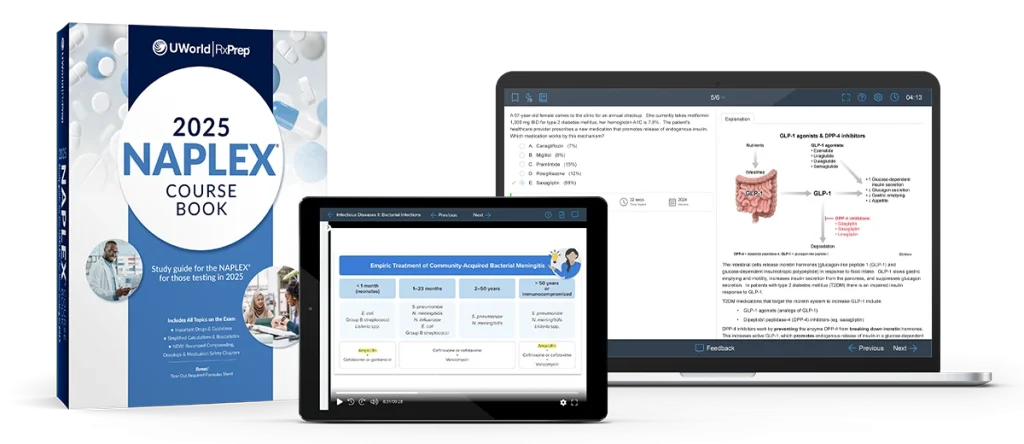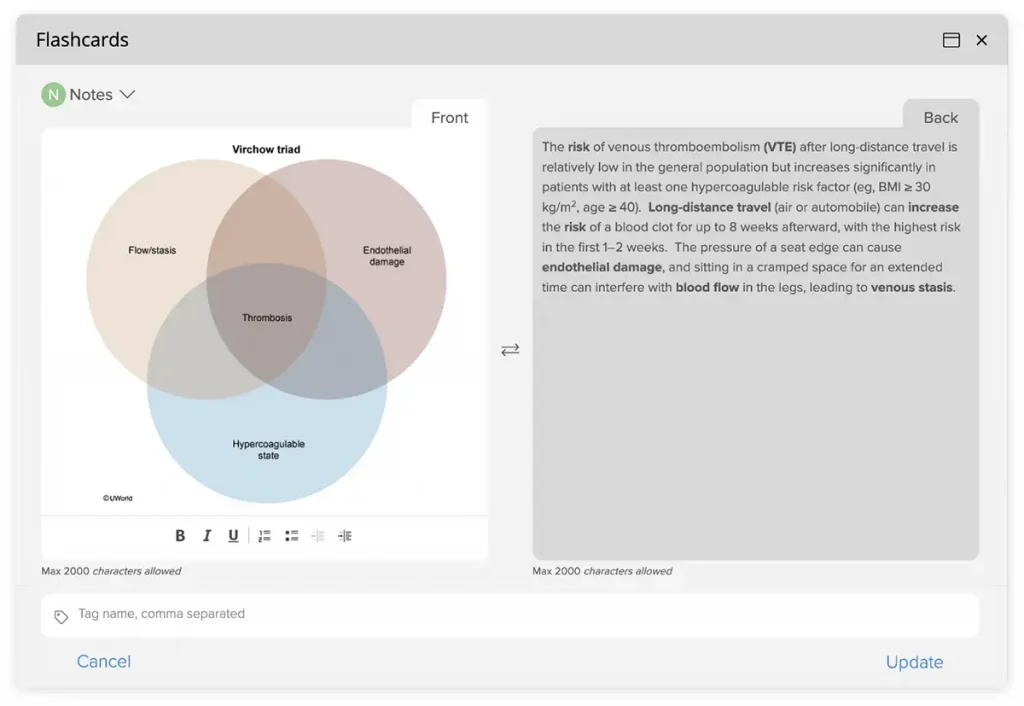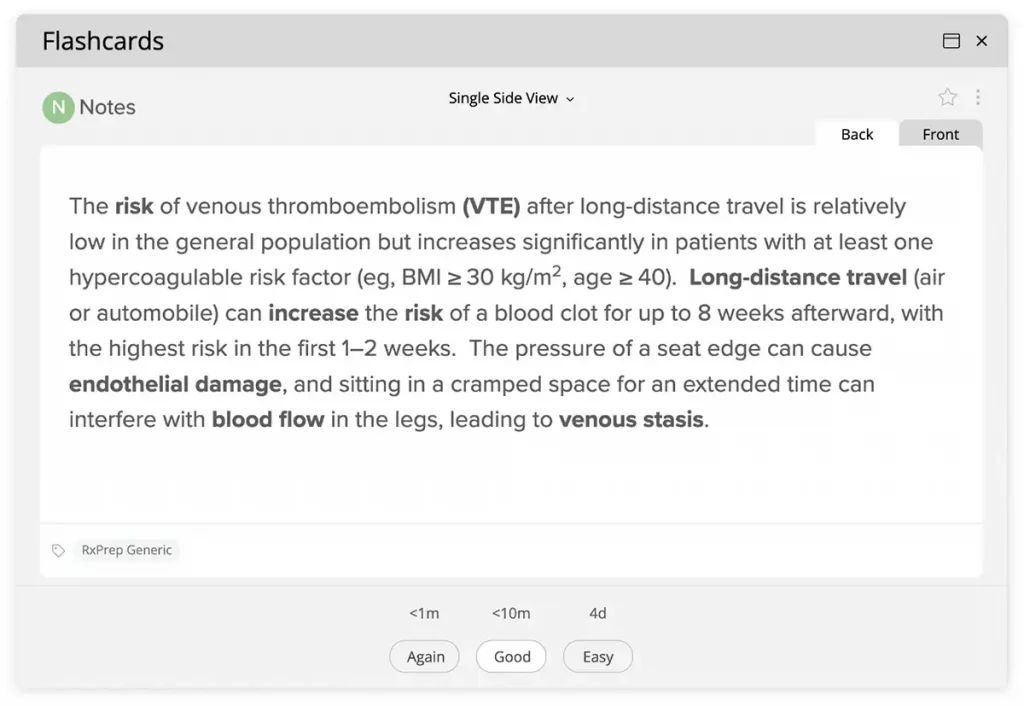
The North American Pharmacist Licensure Examination® (NAPLEX®) is a high-stakes exam that challenges prospective pharmacists to demonstrate mastery of concepts required for pharmacy practice. This NAPLEX study guide will help you prepare for the exam by providing helpful tips and tools for creating an independent NAPLEX study schedule and plan.
What do top performers have in common? Top performers use UWorld RxPrep to ace the NAPLEX.
To pass the NAPLEX, you must demonstrate adequate knowledge and skills as outlined in the NAPLEX Competency Statements (i.e., the exam blueprint). These competencies include the ability to assess patient cases and recommend safe and effective treatments, perform calculations, understand compounding and medication delivery systems; and be proficient with the principles of medication safety.
When taking pharmacy licensure exams, there is no such thing as luck. You must master all topics and complete calculations with adequate speed and accuracy. That’s why it is critical to create an effective NAPLEX study plan. The UWorld RxPrep NAPLEX study materials available on the UWorld RxPrep website cover all of the content outlined in the NAPLEX competencies and can be used to execute your NAPLEX study plan. These materials include the latest UWorld RxPrep NAPLEX course book, question bank (QBank), and video lectures.
The UWorld RxPrep course book is a companion to the UWorld RxPrep online course, which includes the QBank and video lectures. The course book displays highly testable content with bolded drugs, underlined information, and critical concepts in the Study Tip Gals and Key Drug Guys sections. Refer to the “How to Use the RxPrep Course Book” section at the beginning of Chapter 1.
All of the chapters in the course book have a corresponding online video lecture and a question set in the QBank. The course book and video lectures help you refresh on the content, while the QBank questions allow you to assess your knowledge, evaluate your performance, and remediate where needed. The NAPLEX has shifted to a largely case-based exam. You will need to gather information from a case to answer questions such as:
While there are some chapters in the course book that help with case-based questions (eg, Answering Case-Based Exam Questions), the UWorld RxPrep QBank is the best tool to assess your ability to evaluate cases and make patient-specific recommendations. Key features of the QBank include:

Use the tips and insights below to learn how to customize and maximize the use of the NAPLEX study materials. You'll also find information on creating a NAPLEX study schedule as part of your NAPLEX study plan.
There’s no right or wrong order to tackle the subjects and chapters in the UWorld RxPrep course book and QBank. Don't just focus on the clinical chapters; remember that the NAPLEX Competency Statements indicate that the content you learned earlier in pharmacy school (e.g., basic science concepts, drug references, drug interactions, and other foundational topics found at the beginning and end of the course book) is tested. A strong knowledge base in these areas will be essential to help you answer questions in multiple QBanks.
Math is a significant component of the exam and is best mastered with repetition. The UWorld RxPrep study materials include five calculation chapters (in the course book and QBank) plus a Required Formulas Test. Chapter 1 of the course book includes a "Required Formulas Sheet" and a "Checklist" to help you memorize the “must know” formulas. The Required Formulas Sheet is also available as a tear-out at the back of the course book. Starting math early allows you to progress through all of the chapters and learn the key concepts and required formulas while ensuring enough time remains to repeat the QBanks several times, which is needed to obtain both accuracy and efficiency.
Your goal is to complete all of the questions in the UWorld RxPrep QBank, creating tests that mix foundational, calculation, and clinical topics.
Though your pharmacy school courses provide a foundation, give yourself the best chance to succeed on the NAPLEX by studying with your UWorld RxPrep resources, including the NAPLEX QBank, course book, and video lectures. Just as important as using the right materials is creating a robust NAPLEX study schedule for your NAPLEX study plan.
First, it is important that you plan to study all the subjects and chapters included in the UWorld RxPrep study materials. Do not skip any subjects or chapters as they could be tested on your final exam.
How much time to dedicate to your NAPLEX study schedule depends on many factors (e.g., knowledge retention from pharmacy school, practice experience, work and personal commitments). We recommend that you start early (6 months to 1 year before your exam) to minimize the amount of cramming you will have to do (which creates unnecessary stress and anxiety). If you are still in pharmacy school, a longer study period (e.g., 18 months) may help you successfully prepare while completing your curriculum requirements and be ready to test shortly after graduation.
If you start early and study at your own pace over an extended period of time, you can solidify your knowledge of topics, give yourself enough time to complete practice tests, and remediate where necessary before your exam. For some perspective, check out our UWorld RxPrep 3 month, 6 month or 12 month Study Planners.
When you get to a topic on your NAPLEX study plan, use your time efficiently by first assessing how well you know the topic. If you feel confident about your knowledge, perhaps a quick refresher of testable content in the course book chapter (e.g., bolded drugs, underlined information) is all that is needed before proceeding to the QBank for that topic. If you do not feel confident with the topic, spend more time reading the chapter and watching the corresponding video lecture before attempting the QBank.
To complete the QBank questions for a topic, create a test with questions from that chapter. Questions can be completed in tutor mode, which immediately grades each question and provides an explanation upon submission of the answer. QBanks can also be taken in “timed” mode.
At any point in your studies, you can create integrated tests in the QBank by mixing questions from multiple clinical and calculation chapters. Tools that aid in your studies as you navigate the QBank, as well as how to assess your performance, are described below.
As you progress through the UWorld RxPrep NAPLEX QBank, you can create flashcards by transferring written and visual content from the practice questions and explanations to both sides of a new flashcard. You can also add your own notes and create custom tags for improved flashcard searchability.

A "Study" feature within your QBank lets you determine the frequency with which you will encounter your flashcards using spaced repetition, a proven study technique that boosts memory retention. Flashcards you find challenging will appear more frequently, while those you find less difficult will appear less often. Applying spaced repetition to your pharmacy flashcards lets you retain more information over the long term while studying for your board exams.

Flashcards are an effective way to remember content for a high-stakes exam, so we encourage you to incorporate them into your studies. They are a great way to learn key content, such as brand/generic drug names, common drug class side effects, and more. Using flashcards within the UWorld platform also helps keep all of your study resources in one place.
Decide if you know a topic well by reviewing your performance
When completing the NAPLEX question bank: